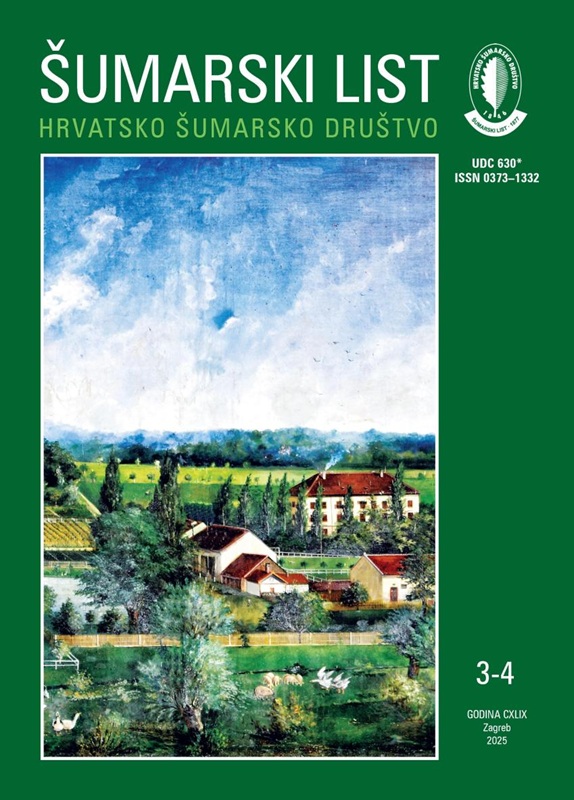| |
| RIJEČ UREDNIŠTVA |
| |
|
|
| Uredništvo HŠD | |
| Deforestation and devaluation of forests in Croatia leads to the collapse of forest sustainability, forest ecosystem services, and their multifunctional role
pdf
HR
EN
|
113 |
| |
| IZVORNI ZNANSTVENI ČLANCI |
| |
|
|
| Damir Drvodelić, Ela Španjol, Marko Vuković, Tomislav Jemrić | UDKps://doi.org/10.31298/sl.149.3-4.1 |
| Medlar (Mespilus germanica L.) fruit morphology depending on fruit size
pdf
HR
EN
|
115 |
| Peter Vindiš, Damijan Kelc, Peter Berk | UDKps://doi.org/10.31298/sl.149.3-4.2 |
| Detection of bark beetle infestations by drone and image analysis in spruce forests
pdf
HR
EN
|
127 |
| Özkan Evcin, Büşra Kalleci | UDKps://doi.org/10.31298/sl.149.3-4.3 |
| New records of marbled polecat, Vormla peregusna (Guldenstaedt, 1770) in Türkiye, current and potential distribution under climate change
pdf
HR
EN
|
137 |
| Kadir Alperen Coskuner, Ismet Harman, Sadiq Zeynalov, Ertugrul Bilgili | UDKps://doi.org/10.31298/sl.149.3-4.4 |
| Exploring long-term wildfire dynamics across land cover types in relation to climate in the Eastern Mediterranean landscapes
pdf
HR
EN
|
153 |
The Mediterranean region is characterized by diverse landscapes and unique climatic conditions, making this region of crucial importance in the context of wildfires. Türkiye is one of the largest countries in the Mediterranean region with remarkable ecological richness, characterized by diverse land covers encompassing a variety of ecosystems and habitats. Fires play a crucial role in shaping ecosystems in fire prone areas in the country. Understanding the relationship between vegetation composition, climatic factors and historical fire patterns is thus crucial for effective fire management and conservation efforts in the Eastern Mediterranean and the world in general. This study reports and discusses fire dynamics in Türkiye spanning from 2001 to 2020 across diverse land cover classes, employing both the ESA FireCCI51 burned area product and ground-based fire data. This study aims to provide insights into the complex relationship between wildfire activities by examining the interactions and long-term climate variables, vapor pressure deficit (VPD) and the Angström index. The analysis of FireCCI51 data revealed different spatial patterns of wildfire occurrence in different landscapes of the study area. Fires were mainly concentrated in needle-leaved and shrubland landscapes in the west and south, while broad-leaved, herbaceous, and agricultural fires were prevalent in various parts of Türkiye. Despite legal restrictions, stubble burning remains a common practice, contributing to fire occurrences, especially during dry and hot periods after harvest. Long-term climate trends, particularly increasing VPD and decreasing rainfall, significantly impact wildfire dynamics in the study area. High VPD values correlate well with increased fire activity, indicating its role in fuel moisture and burned area. The increasing trend in VPD and decreasing trend in the Angström index underscores the landscapes increasing susceptibility to wildfires, suggesting a potential impact of climate change on burned area.
|
| Canpolat Kaya, Ahmet Acarer, Sibel Tekin | UDKps://doi.org/10.31298/sl.149.3-4.5 |
| Global climate change, a threat: example of the chamois’ case
pdf
HR
EN
|
169 |
| |
| PREGLEDNI ČLANCI |
| |
|
|
| Louiza Soualah, Mouatez Billah Boussouf, Abdelhafid Bouzekri | UDKps://doi.org/10.31298/sl.149.3-4.6 |
| Trends in research on forest fire mapping and management: a bibliometric review
pdf
HR
EN
|
183 |



